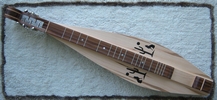Extended Range™ Dulcimers
The Extended Range™ dulcimer is a concept I came up with years ago, but only recently got around to building. To the best of my knowledge no one else has built this type of dulcimer before. The concept is to combine a normal 4-string dulcimer with a 3-string baritone dulcimer. The result is a 5-string dulcimer,
which could be considered a standard dulcimer with an extended range on the bass side
or a baritone dulcimer with an extended range on the treble side. In any case it
has a much fuller sound than a normal dulcimer and allows for chord inversions
not possible on a standard fretboard;
(Note: Since I originally published this little article
in the early 2000's everyone
seems to have jumped on the bandwagon and now build their version of a combined
regular/baritone or baritone/bass dulcimer).
The standard tuning for the Extended Range™ is DD A D A (similar to DAD) or AA A D A (similar to DAA tuning). From a music theory standpoint the addition of the low A, which is the dominant 5th in the D major scale, extends the range of playable melodies and offers the ability to play much fuller chords. Many melodies drop down below the tonic to the dominant 5th in the last few bars of the tune then resolve back to the tonic note. Or in plain English, many melodies in the key of D will drop below the note D to an A. There are many reasons for this from a music theory standpoint, but basically it brings the melody “back home” at the end of the verse. With a normal dulcimer the lowest note is D. So there is no way to drop down to the dominant A and play the melody correctly. The addition of the low A “opens up” the bass side for more complete melody playing. Note: If you are familiar with chords you have probably noticed that in the key of “D”, the “A” or “A7” chord is commonly played in the last few bars of the song before coming back to end on the “D” chord. This is what the low “A” allows you to do on this dulcimer.
Another area where the Extended Range™ opens up possibilities is in playing chords on the dulcimer. With the added lower “A”, chords not only sound much fuller but the lower string allows many possibilities with chord inversions or simply playing more complete chords.
Click Here To Listen to an Extended Range™ dulcimer
An additional feature of the Extended Range™ is that it is in essence two dulcimers. Pins can be installed on the side of the fretboard that allow either the low “A” string or the melody strings to be pulled aside. With the bass string pulled aside, the dulcimer would play like a normal dulcimer. With the melody strings pulled aside, the middle string can be tuned up to “E” and the dulcimer played as a normal baritone dulcimer tuned AEA. But I have yet to hear from anyone finding it necessary to do this. It seems that once you get accustomed to the setup you can simply play the strings you want in either mode with the standard setup.
The standard Extended Range™ range dulcimer comes with 1½ & 8½ frets in addition to the now standard 6½ & 13½ because this dulcimer is intended for mid-range to advanced players or musicians who increasingly ask for these frets to be added. Of course, it can be made with any fret configuration from the traditional non- 6½ fret to fully chromatic. But in any case, I would never recommend this dulcimer for a beginner unless you are already an accomplished musician on another stringed instrument such as a guitar, banjo or mandolin.
